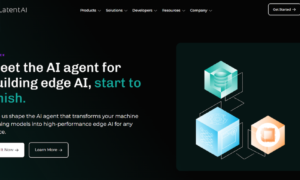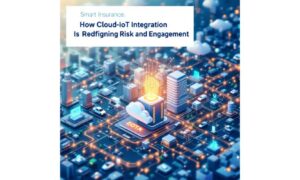What is IOT
The Internet of Things, or IoT, is a network of interconnected computing devices, digital machines, animals, objects, or people that have unique identifiers and can transfer data over a network without human-to-human or human-to-computer interaction.
A person with a heart monitor implant, a farm animal with a biochip transponder, a car with built-in sensors to warn the driver when the tire pressure is low, or any other living thing or machine that can be given an IP address and can transfer data over a network can all be considered things in the internet of things.
Businesses in a wide range of industries are using IoT more and more to streamline operations, and better understand their clients so they can provide better customer service, enhance decision-making, and raise the value of the company.
How Does it Work?
The Internet of Things (IoT) ecosystem is made up of web-enabled smart devices that use embedded systems, like processors, sensors, and communication tools, to gather, send, and act on the data they receive from their surroundings. IoT devices communicate the sensor data they gather by connecting to an IoT gateway or other edge device, which either sends data to the cloud for analysis or analyzes it locally. These gadgets periodically converse with other gadgets that are similar to them and act on the information they share. Although users can engage with the devices to configure them, give them instructions, or retrieve data, the devices handle the majority of the job without their help.
WHY IS IT SO IMPORTANT?
People who use the internet of things can lead more intelligent lives, do better work, and have complete control over their destinies. In addition to offering smart home automation equipment, IoT devices are essential for business. With the help of IoT devices organizations can see in real-time how their systems actually function, gaining insights into anything from equipment performance to supply chain and logistics activities. Businesses may automate procedures and save money on labor thanks to IoT devices. Moreover, it lowers the cost of manufacturing and distributing goods, improves service delivery, reduces waste, and offers transparency in customer transactions. IoT is one of the most important technologies of the contemporary era as a result, and it will continue to grow as more businesses realize the benefits of connected devices.
What advantages does IoT offer businesses?
Organizations tend to gain a great deal from the internet of things. Certain advantages are unique to certain businesses, while others apply to many other industries. Some of the typical advantages of IoT for businesses include:
- Monitor their whole company processes
- promote staff productivity
- enhance customer experience (CX)
- save time and money
- integrate and adapt business models
- optimize business decisions, and increase revenue.
IoT provides businesses with the tools they need to improve their business plans and forces them to rethink how they run their operations.
But, it has also discovered applications for businesses in the infrastructure, home automation, and agriculture sectors, pushing some businesses toward digital transformation. The use of sensors and other IoT devices is generally most common in the manufacturing, transportation, and utility industries.
Farmers can benefit from IoT use in agriculture by having their tasks made simpler. In order to automate farming processes, sensors can collect data on the soil’s composition, temperature, humidity, rainfall, and other factors.
The ability to monitor infrastructure-related operations is another benefit of IoT. For instance, the structural components of structures, bridges, and other infrastructure could be monitored using sensors to detect changes or advancements. Cost savings, time savings, improvements to the workflow’s quality of life, and paperless workflow are all advantages of this.
A home automation business can utilize IoT to manage and keep an eye on a building’s mechanical and electrical systems. Smart cities can help citizens use less energy and rubbish on a greater scale.
IoT has an impact on every business, including those in healthcare, banking, retail, and manufacturing.
Use cases of IoT
IoT use cases are there for both domestically and commercially. Examples of domestic uses include home security, thermostats, and lighting fixtures. These multiple applications can be broadly divided into those that are used by consumers, businesses, industries, and infrastructure.
These are a few typical IoT technology applications
IoT in agriculture
- Improved crop yield: IoT sensors and devices can help farmers to monitor soil conditions, humidity, temperature, and other variables that can impact plant growth. With this data, farmers can make more informed decisions about when to irrigate, fertilize, or harvest their crops, potentially leading to increased yield and better-quality produce.
- Reduced resource consumption: IoT devices can be used to optimize resource usages, such as water and energy, by collecting data and automating processes. This can reduce waste and costs, as well as environmental impact.
IOT in Clientele-Oriented Programs
The Internet of Things (IoT) offers a wide range of consumer applications, such as connected cars, connected health, connected homes (including lighting and sound systems), wearable technology, and appliances with remote monitoring features, such as doorbells with remote video capability. They are all present in the smart house.
Smart-home application software
A home with IoT capabilities has media and security systems in addition to lighting, heating, and cooling. As unnecessary equipment is turned off, energy can be saved. Many smart homes are built on a single platform or hub that connects to smart devices and appliances. They are typically controlled by a smartphone, tablet, or other devices, occasionally without the need for a Wi-Fi bridge. These devices can be linked to open-source ecosystems like Home Assistant or standalone platforms like the Apple HomePod or Amazon Echo.
IOT Applications for Care
Internet-capable devices can also offer significant support to the elderly or people with impairments, enhancing their quality of life. For instance, voice-activated devices can assist those who struggle with eyesight or mobility, while alert systems can be directly paired with cochlear implants to assist those who are hard of hearing. Also, sensors can watch out for health problems like falls.
IOT Apps for transportation
Inter- and intra-vehicle communication, intelligent traffic control, intelligent parking, toll collection, logistics, fleet management, vehicle control, safety, and road assistance are all examples of applications for the Internet of Things in the transportation sector. IoT can connect autos with the transportation network via vehicle-to-everything (V2X), vehicle-to-vehicle (V2V), vehicle-to-infrastructure (V2I), and vehicle-to-pedestrian (V2P) communication (V2P). These IoT connection networks are aiding the development of autonomous vehicles and connected road infrastructure.
IOT in Construction
The mechanical, electrical, and electronic systems in a range of building types can be monitored and managed by IoT devices. Due to their integration with the Internet, smart buildings can help reduce energy consumption and track tenant behaviour.
What’s the future of IoT?
The future of IoT appears promising thanks to new technologies and access to information that we previously would not have thought possible. In the near future, we could expect more stringent security laws as well as substantial adjustments to the way our data is managed. IoT will continue to serve as the foundation for numerous technologies that will revolutionize how we all live. The current state of this industry is undoubtedly exciting.



































